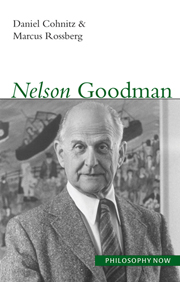Book contents
- Frontmatter
- Contents
- Acknowledgements
- Abbreviations
- 1 The worldmaker's universe
- 2 If this were an emerald it would be grue: problems and riddles of induction
- 3 The big picture
- 4 Particulars and parts
- 5 From Vienna Station to Boston Terminus
- 6 Follow the sign
- 7 Diagnosing art
- 8 Starmaking
- 9 Never mind mind, essence is not essential, and matter does not matter
- List of symbols
- Glossary of technical terms
- Further reading
- Notes
- Bibliography
- Index
7 - Diagnosing art
- Frontmatter
- Contents
- Acknowledgements
- Abbreviations
- 1 The worldmaker's universe
- 2 If this were an emerald it would be grue: problems and riddles of induction
- 3 The big picture
- 4 Particulars and parts
- 5 From Vienna Station to Boston Terminus
- 6 Follow the sign
- 7 Diagnosing art
- 8 Starmaking
- 9 Never mind mind, essence is not essential, and matter does not matter
- List of symbols
- Glossary of technical terms
- Further reading
- Notes
- Bibliography
- Index
Summary
In this chapter we outline Goodman's philosophy of art, which can largely be found in his Languages of Art, with some additions made in Ways of Worldmaking and Of Mind and Other Matters. Goodman presents a symbol-theoretic approach to art. Artworks are (complex) symbols, and as such function cognitively. Elgin called this “Goodman's Epistemic Turn” (1997a: ch. 3). Art, like science and philosophy, contributes to our understanding. Artworks present a world version (see Chapter 8), but in order to do so, they, in turn, must be understood:
To understand a portrait, a partita, or a pas de deux, Goodman believes, is not to consider it beautiful, appreciate it, ascertain what its author intended by it, or have a so-called “aesthetic experience” of it. Rather, to understand it is to interpret it correctly – to recognize what it symbolizes and how it fits with or reacts against other world version and visions. Understanding works of art is not a matter of passive absorption, but of active intellectual engagement with symbols whose syntactic and semantic features are often elusive. No more than in science is correct interpretation in the arts assured. Thinking you understand a symbol does not make it so.
(Elgin 1997a: 63–4; see also WW: 109–40)In philosophy of art as in the other philosophical areas, Goodman is far away from postmodern philosophers, who often tend to declare him one of their own. One has to get the interpretation of an artwork right. It is not the case that anything goes; indeed, most things do not.
- Type
- Chapter
- Information
- Nelson Goodman , pp. 164 - 190Publisher: Acumen PublishingPrint publication year: 2006



